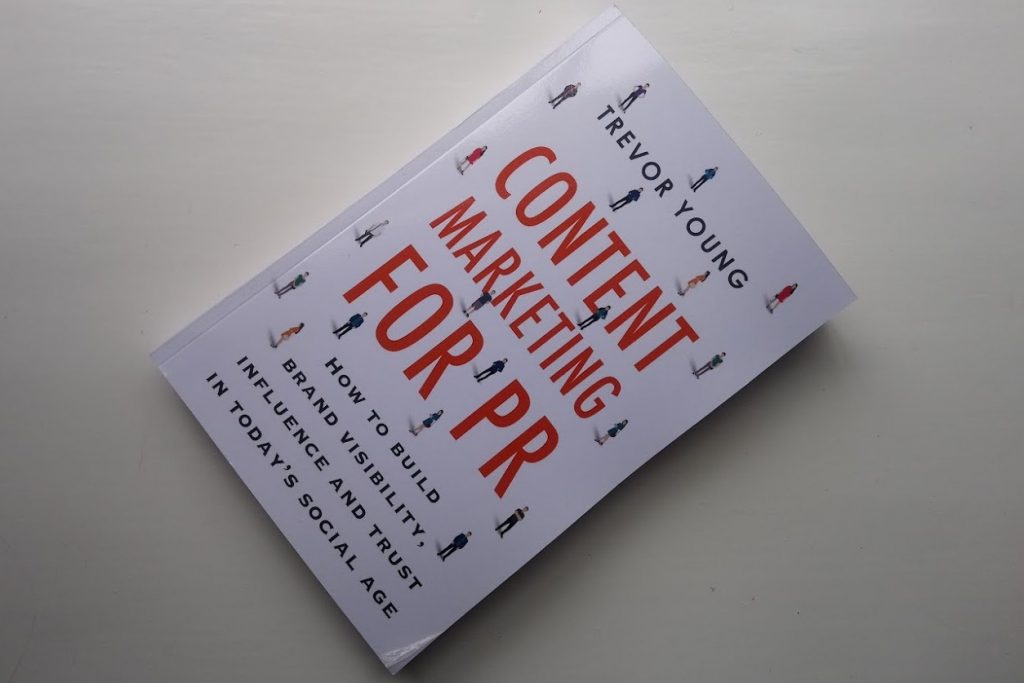Review: Content Marketing for PR

About the author
Richard Bailey Hon FCIPR is editor of PR Academy's PR Place Insights. He teaches and assesses undergraduate, postgraduate and professional students.

Content Marketing for PR:
How to Build Brand Visibility, Influence and Trust in Today’s Social Age
Trevor Young
Digital Citizen, 2019, 378 pages
Content marketing, like influencer marketing, is such a familiar phrase that few pause to question the use of language. In truth, these disciplines are closely aligned to public relations – and in some respects marketing is too limited a concept.
So I am pleased to note the rehabilitation of PR in this book’s title. The author, an experienced Australian consultant and blogger, goes further at the start of the book when he admits he will have little to say about the ‘sales funnel’.
That’s because when you look at content through a PR lens… the approach is broader and more holistic than marketing on its own. In other words, there is a deeper role content can play in your business or organisation over and above directly influencing the sales process… Indeed, PR can help make the marketing function work more effectively overall.
Yet the misunderstanding starts from people’s perception of what public relations is and what it does for the organisation. Young is keen to restate the broader role of public relations. ‘There’s more to PR than getting ink. At its core, PR is about building recognition, relevance, reputation and relationships.‘
Having clarified the confusion between publicity and public relations, the author turns to another two overlapping concepts: brand and reputation. NIKE illustrates the distinction: a business that has focused heavily on its brand but yet which has faced threats of a consumer boycott over its business practices. ‘The lesson? A strong brand does not necessarily equate with a good reputation.’
Turning to content marketing, the author provides this definition of the practice:
Strategically creating, publishing and amplifying original content that’s of interest, relevance and value to a specific audience, with the ultimate goal of influencing a desired outcome.
He provides the context for the shift in media consumption in the proliferation of media channels, our short attention spans and finite time, and an opt-in culture where we seek to control the flow of information and know that we need to screen out noise.
At this point, some explanation is needed over the distinction, if any, between content marketing and inbound marketing. The latter was a term coined by the founders of HubSpot, a customer relationship management platform. ‘The inbound marketing process is unashamedly all about leads and sales specifically and focuses heavily on using content to drive traffic to your website and then getting as many prospective leads as possible into the top of your sales funnel… Inbound marketing is very much about process.’
Compare that approach with content marketing for PR, which ‘helps brands differentiate themselves from their competition, whether they are articulating their brand story and the purpose of their business, taking a stance on a particular social issue, whisking people behind the scenes in their organization or educating their audience about a burning topic that’s affecting their industry. These are all effective ways for brands to stand out from the competitive pack.’
Young identifies four types of content.
-
- Utility content answers people’s questions and is educational.
- Leadership content is designed to spark debate and conversation.
- Corporate content, because ‘you will never stop businesses from talking about themselves.’
- Promotional content that contains a call to action (‘buy our product!’)
The heart of the book contains a useful framework for planning a content strategy (starting with listening). There’s also a good overview of the surprisingly long history of blogging. Blogs may no longer be the centre of conversations, but as prime ‘owned media’ real estate they’re central to a content strategy.
But it’s not all words. One chapter looks at video (‘an emotive medium, it can help build connection with viewers which, in turn, enhances people’s trust in a brand.’) Another at audio content (‘the unsung hero of content marketing’).
Then he turns to social media – ‘an insatiable beast that requires constant feeding.’ He warns against a diet of junk food, and argues instead that while ‘micro-content might be small… in aggregate it can be big.’ What’s required is thoughtful planning.
Then there’s original, long-form (‘premium’) content such as whitepapers, e-books, tutorials and webinars. The combination of signature content plus micro-content, is ‘a match made in PR heaven’.
But should your signature premium content be freely available, or be kept as gated content? ‘Conventional wisdom is to gate the content so you can gain access to someone’s email’ but this risks reducing the effectiveness of SEO because search engines can’t access your content in order to rank it. Plus, people are less likely to share gated content.
There is a hybrid option: to gate the premium content for a period of time when first published, and then to set it free.
Then to the ‘less is more’ paradox. What’s the right balance between content creation and content promotion? ‘When it comes to content marketing today, quality trumps quantity every time. Quality plus consistency should be the main aims of the game.’
It’s a useful book, full of examples and lived experience. The author will be hoping to reach a wider audience and gain greater reputational assets than through blogging alone, though print has some downsides. The ideas have a long shelf life, but some of the examples cited and programs and apps named will date quickly. It’s a self-published book written for a general business audience, and I’d describe it as functional rather than handsome as an artefact.
Having opened with a rejection of the ‘sales funnel’ as too reductive (because not every important relationship is commercial), where’s the big idea to put in its place? How about community building? Perhaps that’s for another book.